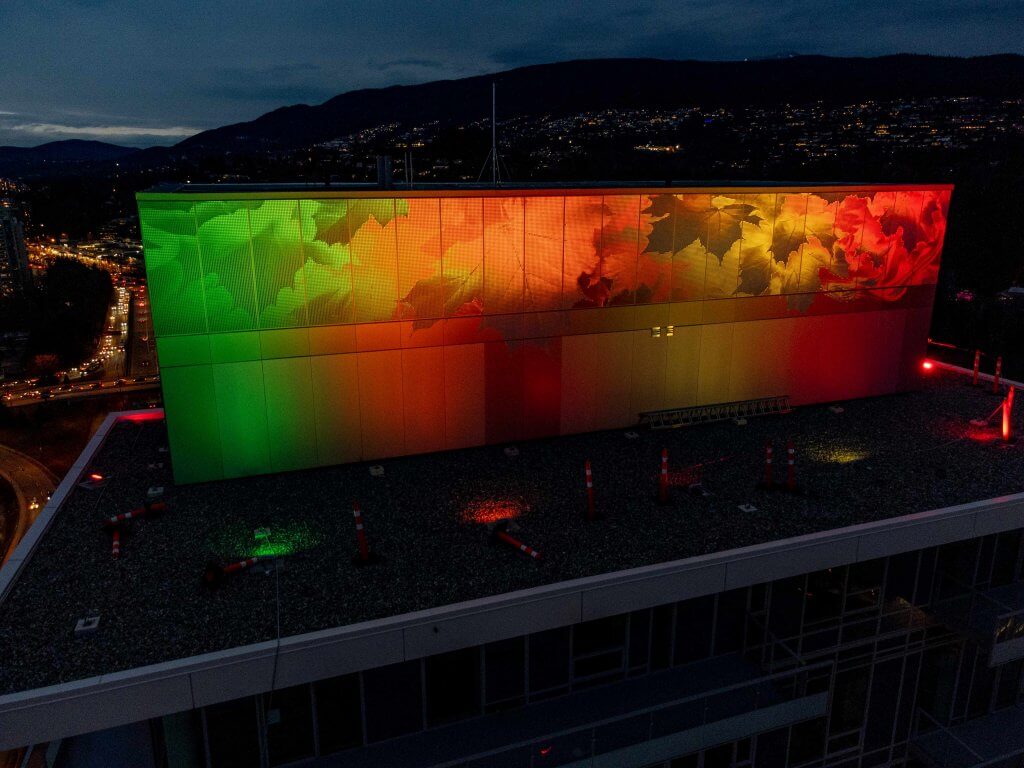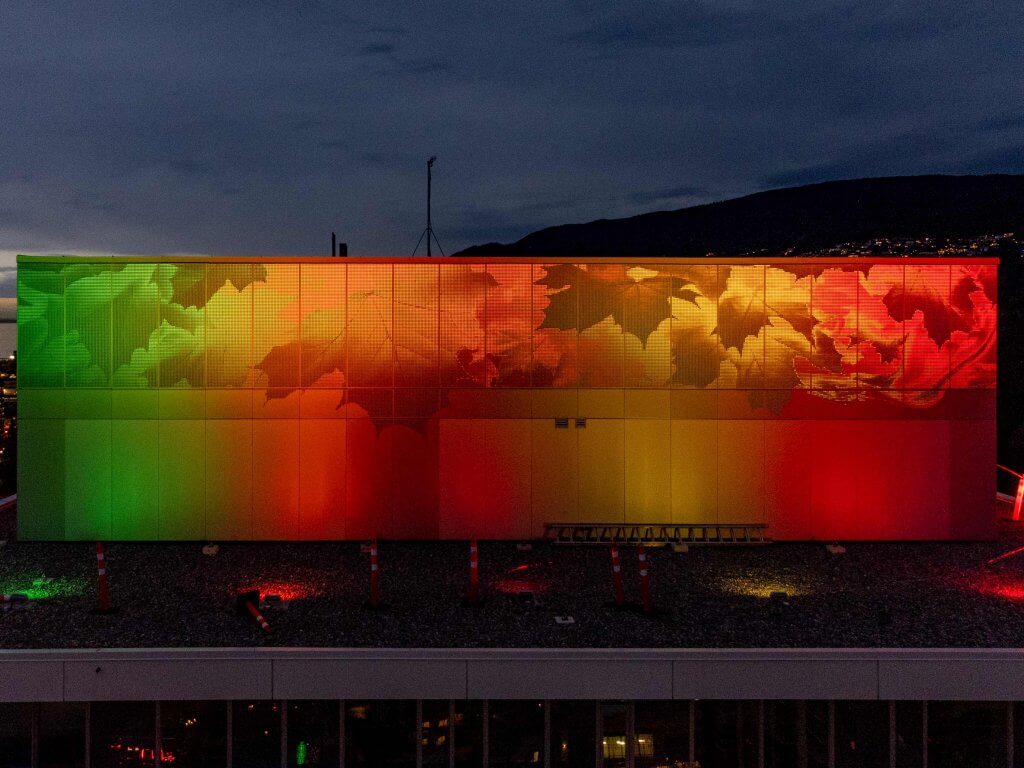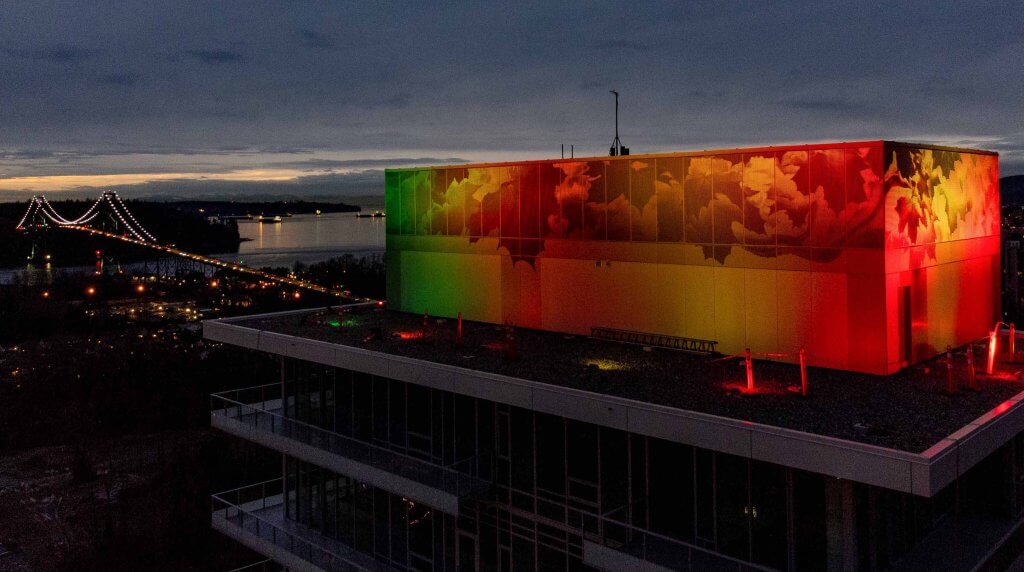An interview with Roderick Quin describing the newly installed public art on The Sentinel development in West Vancouver
Can you describe the artwork’s inspirational origins?
The idea for the maple vine motif, Ombrae Vinea Canopy, started from a rough placeholder design of branches that came from the architect and client. I took that idea, and developed my own design based on the maple leaf: the Canadian national emblem. From my personal photography of boulevard maple trees in my neighborhood in East Vancouver, I created a cache of images during the summer and fall.
From a collection of over one hundred original photos taken over many months, the images were edited, composited, and then assembled into a design comprised of a few hundred Photoshop layers that, with the smart hands and eyes of my colleagues Jared Korb and Brian van Zanden at Ombrae Studios, I developed into the final design for The Sentinel facade.
What is the meaning behind the artwork’s title?
Ombrae Vinea takes its inspiration from the Ombrae System’s Sculptural Imaging™ technique and technology: “Ombrae”... Latin for many shadows, and “Vinea”… Latin for vine. It’s intended to speak to the cultural diversity of Vancouver, and carry a national and international message of inclusivity to Canadians, and those who travel from around the world to visit Vancouver.

How is the work’s physical location significant?
Ombrae Vinea is visible from many angles and distances. The Sentinel tower is 26 stories high, with the crown of the building facing east, south, west, and north. The maple leaf design wraps all four sides of the building.
The principal views face south and west with the most prominent distant lines of sight being from downtown Vancouver and Stanley Park. There are dramatic views of the artwork from the Lions Gate Bridge crossing northbound and those traveling east and west along Main Drive.
Can you describe the creative process that went into the artwork’s development? How did the initial concept evolve over the course of the project?
At Ombrae Studios, we work closely with many stakeholders in our public art installations. Project teams are often composed of an architect, developer, and the owner’s representative. A key member of the design development process is our Canadian manufacturing partner Keith Panel Systems (KPS), based here in Vancouver.
Sculptural Imaging™ has unique and subtle characteristics. Ombrae Studios, has by necessity, a lot of input regarding design and the technical aspects during a given project's development. The architect and client receive our input from the initial design concept to the creation of the final production drawings issued to our manufacturing partner.
For The Sentinel, we also worked closely with the lighting design team to work out the best-case setup for feature lighting the Ombrae surface. Final on-site optimization consultation with the lighting controls specialist was an exciting completion point for the artwork: we programmed each of the 36 individual light fixtures around all elevations, to maximize the Ombrae Vinea maple leaves’ colours and depth.

In what ways did a sense of scale factor into the work?
The maple leaf motif was well-suited to address the viewing distances involved to get a clear reading of the design at distance. Some of the largest leaf elements in the design are 20 feet across.
What are some of the challenges posed by creating artwork of this scale in Ombrae?
Ombrae is well-suited for architectural applications since Ombrae’s 3D pixel elements (Optical Tiles™) can resolve designs on large exterior or smaller interior surfaces.
Even at extremely small scales, Sculptural Imaging™ works well. We work in automotive and product design applications, where Ombrae pixels are sometimes created at micro-scales less than a millimeter. For The Sentinel, the Optical Tiles™ (3D pixels) are 1 inch (25mm) in diameter.
What makes Ombrae unique as a facade treatment?
Ombrae’s characteristics are unique in that a Sculptural Image™ is composed of multiple, identical “sculptural objects: 3D pixels or Optical Tiles™” .
Generally speaking, Ombrae surfaces can be rendered at various scales and in various materials becoming what I call an “Image Object.” The Image Object is responsive, like a traditional sculptural object would, to the lighting conditions of a given time, location, and angle of the viewer’s position. Some have called Ombrae holographic because of its almost fully 3D effect on a flat surface. Ombrae Sculptural Images have the look and feel of the original subject of the image; the subject is transformed by Ombrae to behave like a real object in real space.
The 3D pixels are assembled in large arrays that are programmed into a given design through our proprietary process and custom computer software. The creation of virtual 3D models gives us the ability to previsualize, and then analyze, our design before committing it to the physical manufacturing stage.
A single Sculptural Image™ design for an architectural facade such as The Sentinel, can have thousands of 3D pixels. The facade is sectioned out into standardized architectural panels for a specific facade application. The manufacturing process creates each panel on a CNC stamping machine. The facade assembly and substructure is engineered to architectural specifications for placement on the building.
What emotion or viewer reaction were you looking to evoke from the artwork?
I think the dramatic scale of an Ombrae Sculptural Image is initially the most impactful to a viewer: architectural image-making at a cinematic scale. We experience images on the movie screen as larger than life. I’m very interested in the idea that the architectural applications of Ombrae elevate the cityscape into a cinematic/holographic display: a dynamic, interactive multi-dimensional experience.
What is the relationship between artist, developer, and architect, amidst the rest of the project team?
My twenty years in the Hollywood film industry as a set designer, set builder, scenic artist, sculptor, and special visual effects technician, taught me that big things need big teams with diverse skills, to bring a project together for a successful completion. All the parts must work in concert: prescribed by, and directed from, the design intention. Of course, this was always subject to budgetary concerns, but ultimately, and most importantly, the stories we were telling together remained the collective focus.
Now, working in architecture, industrial design, and product design, it's the same kind of work with collaborative involvement with clients, and their design teams, to tell their stories. That is a very exciting and fulfilling part of my work with Ombrae.
How did the medium of Ombrae inform the artwork’s development?
As Marshall McLuhan said, “The medium is the message.” I think fundamentally there is a relationship between how something is made, how it is used, and how it’s perceived. Through the history of art and architecture into our modern times, materiality is the primary feature of the design process, its making, and its final messaging. This has always been true and will remain so for me as an artist in our post-industrial, postdigital age.
It's been my good fortune to become an artist in a world, and at a time, where so many new ideas, materials, processes, and techniques can come together to form my artistic tool kit.
I like to use the metaphor of the sculptor’s hammer and chisel: in my work as a postdigital artist in the 21st century, “The computer is my hammer, and software my chisel”.
What lasting legacy do you envision the work having on the surrounding area over the coming decades?
Architecture is meant to last. It’s through memory that Ombrae will register with the urban viewer as a placemaking medium and signifier of meaning over time.
It is my belief that those that live here, and those that visit, will get a deep and memorable experience of Vancouver from The Sentinel artwork: reinforcing a dynamic sense of place through the Ombrae experience. These experiences can become deeply embedded physically, conceptually, and emotionally. They become anchored in body/mind memory. Enduring legacy is made this way.
The Ombrae philosophy is a commitment to building and enhancing the urban realm. We’re actively working to elevate the visual and physical experiences of those living in the city by physically communicating intellectual and emotional meaning, with the intention of deepening a sense of place and identity.
Describe how Ombrae works as an architectural communications technology and what impact it’s intended to have on the urban environment.
Our culture and society have evolved quickly to become highly visual by virtue of the rapid advancements in computer-based digital imaging technology. Screens of various types and scales now dominate our lives. Architects, urban designers, and policy-makers are now carrying this awareness into the way cities are planned and implemented. Modern city dwellers, individually and collectively, will continue to evolve their expectations based on the prevalence of digital surfaces. It is now a major point of interest and concern of technology developers, architects, urban designers, social scientists, and academics worldwide.
We now live and navigate in a cinematic environment. From handheld devices to buildings, “image” is the new visual language iconography of urban communication. Within this cinematic hologram we tell our stories, reflected in the mirror of the social geography within the city’s urban landscape.
Ombrae is a natural and evolutionary outcome of the impact of digital communication, breakthroughs in architecture, and material manufacturing technologies. It is able to signify, narrate, and inform at architectural scales. Ombrae is not an actual social media platform per say. It functions on more emotional levels: quietly, subtly messaging meaning on a deep level of recognition. It reifies our sense and awareness of the city’s placemaking identifiers: creating navigational memory-markers in motion, in real time, in real space.
How and when did computer technology impact the genesis of your creative work as an artist?
At university in the 1980’s, it was becoming clear to me from my studies that art, and what was called art, looked like it was moving toward some kind of paradigm shift. Computers, technology, breakthroughs in physics and perceptual psychology were forces acting to move artists' attention away from the traditional definitions of art and artistic practice. This had a huge impact on my own artistic theory and practice. It influenced the works I was producing into the 1990’s.
At that time, I was being influenced by artists that were thinking outside the traditional boxes of the gallery and the museum. They moved outside into the landscape and urban environments, defining natural and architectural space itself as their medium. They were moving to the computer science laboratories, onto factory floors, and collaborating with scientists, architects, and engineers.
I became excited by what I imagined could be a very powerful design tool for creating sculptures that could not be designed nor built by any other means available at the time. After graduation in 1985, and my first few years working as a scenic artist in the film industry, I opened my own studio in downtown Vancouver. It was there in 1992, that I began to use computers and electronics in the design process, and created my initial architectural sculptural works.
I was invited to participate with the Computer Science Lab at the University of British Columbia in 1993, as an artist in residence to be involved in an advanced innovative program that brought computer scientists and artists together to collaborate.
I had the fantastic opportunity to work with graduate students that helped me develop and design my first computer-based 3D sculptural models. It was during this time that I conceived of building a 3D pixel sculpture. It was my first step in implementing the power of computing to build arrays of 3D pixels into fields that were driven by my design inputs via 3D modeling software programs.

How has the evolution of computing since then affected the potential of the Sculptural Imaging™ Ombrae System, as a technological and artistic platform?
After graduating from university in 1985, and through my years in film production (1987 - 2006), I was able to build on my passion for sculpture, architecture, and technology. By working on major Hollywood films, I had the unique opportunity to design and build exotic structures including mountain sides, glaciers, forests, automobiles, spaceships, and distant science fiction cities and worlds. Through this time, I continued to pursue my passion for architecture and sculpture with personal projects in my studio—bringing my movie experience together with architectural sculptural projects for public art.
It was in my own studio, away from the film business in the early 1990’s, that my expanding interests in digital photography, optics, and acoustics started to focus my research specifically on the interaction of light on surfaces. It was then that I bridged the analogue and digital with the creation of a 3D pixelated surface that could create Sculptural Images™ with OpticalTiles™.
Throughout this entire development period, I had been trying to get traction with the established Canadian art institutions and gallery system, but with no luck.
I did manage to have two art gallery shows, one in 1986 - Section d'Or and another in 1993 - Cyclopia. These installations did more to cement my idea that architectural sculpture was my path forward, than actually attracting any traditional critical attention to my work.
Once I had created the first successful manufacturing prototype of Ombrae in 2003, I realized that the best thing I could do was to establish it as an industrial product design. My strategy became finding and advancing my art through direct relationships with architectural and product design channels. This was the key decision that has led me to the point now, twenty years later, that I have been able to establish my work, not only as an artist but as an architectural and product design technologist.
It's been perhaps fortuitous, in retrospect, to not have been successful in the traditional venues of the art world. Following my initial instinct to develop my artistic vision alone through Ombrae has, I believe, led me to much more interesting and meaningful opportunities.
- Roderick Quin, Artist